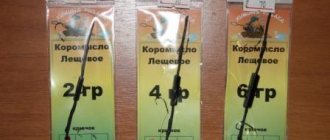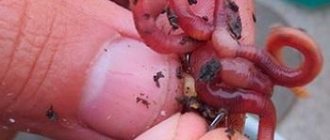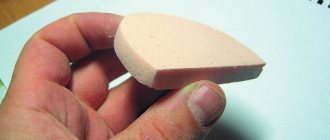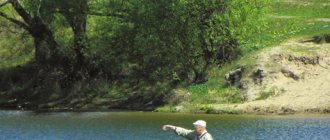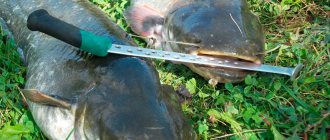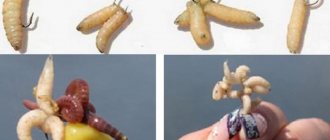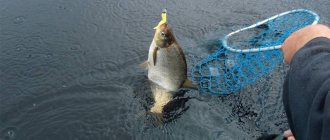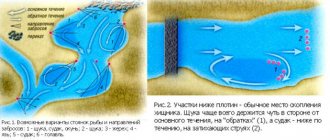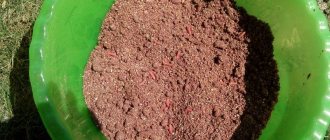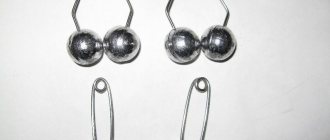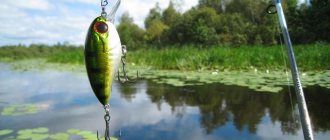Versha
One of the types of fishing tackle is tops, which were known back in Ancient Rus' (you can read about this in “The Wise Minnow” by Saltykov-Shchedrin). This tackle is made from willow twigs and has a frame cone-shaped design. In some regions of our country, the top is called a muzzle (it has two entrances at both ends), as well as norot, venterem, nersha .
The top does not allow the fish that has swum into it to get out, since the captive’s muzzle is stuck into the cone, and it cannot turn around and break free. Only crayfish can walk backwards. However, this tackle is also used for catching crabs.
In simple terms, a top is a bottom fish trap when there are no other ways to catch fish. Nowadays, in addition to willow rods, metal and nylon mesh are also used. The design itself resembles a venter or muzzle, but does not have a guide wing. This gear is usually used to catch perch, and in the Finnish northern rivers they practice catching lampreys.
Top fishing technique
Top traps are used with or without bait during the spawning period of fish. Large silver crucian carp can be caught using the trap we are considering with bait installed in it at the moment when it has just come out of hibernation. At this time, the fish are the most voracious, they flock together in schools, scour the reservoir in search of food and willingly go to the top in which the bait is placed. Up to fifty crucian carp can be crammed into the trap while the school is near the top. But after some time, without getting food for themselves, the rest of the fish leaves, and the trap can stand empty for several hours in a row.
Catching fish with the top using bait is not at all difficult. The trap is set either in thickets or between large stones and boulders. The bait is placed approximately in the middle of the structure. Feeling the smell of food, the fish is drawn there as if under hypnosis. The hole in the trap is made in such a way that it is impossible for the fish to escape; it gets stuck inside the top. But it is useless to place a trap with food placed in it in a clean and open place. The most catchy places are passages between large stones, a washed-out bank, thickets of aquatic plants, as well as narrow sections of streams and rivulets.
Fishing with a top in the spring and summer in spawning areas is perhaps the most effective. This is due to the fact that during spawning the fish are forced to accumulate, and they also need to rub against any hard objects, for example, stones, or dried reeds, etc. At this moment, the fish seems to squeeze caviar or milt out of its body.
With this method, you need to thoroughly study the habits of the fish you are planning to hunt, as well as the spawning site. For example, pike, bream and crucian carp go to spawn in shallow water, but finding a spawning area for perch or tench is problematic. Sabaneev, a famous classic fisherman, advised making dams for spawning using branches or stones. And then install it on the bottom. But Sabaneev himself believed that this method of fishing is almost barbaric, since it injures the fish and deprives it of the opportunity to reproduce.
The essence of top fishing in the summer is that the trap is placed with an open entrance against the current. The fish, walking after spawning, hits the top and gets stuck in it. It should be remembered that spawned fish are inactive, “in no mood,” and therefore you cannot do without bait here. Let's consider a method of catching crucian carp, for example, in a pond. In this case, dried bread or a roll, generously moistened with vegetable oil, works well as bait. If you don't mind, you can also use cream. The trap can be placed in any place you like. One way or another, a crucian carp that smells the oil will certainly go to the top. It is fair to say that in this case the catch will be unsatisfactory. To make fishing successful, you need to follow the following recommendations.
First of all, you need to choose the best place to fish. Such places inhabited by perches, pikes, and silver carp should be excluded. This can be easily explained by the fact that the silver carp is larger, so it will not hit the top, and besides, it is larger in number than the golden one. Therefore, you need to look for places where golden carp live.
To catch large-sized golden crucian carp, you need to use a top covered with a mesh, the cells of which are approximately 4–5 cm. The bait itself must be placed in a small bag, also made of mesh, but with smaller cells. This “vessel” must be placed in your trap so that the bait does not spread throughout the reservoir through the cells of the top. Bread or other grain products are used as bait.
To find the “right” fishing spot, you must first determine whether large crucian carp will bite here, and whether this place is its “dining table.” You can determine a potential feeding point before dawn using a traditional fishing rod. It is at this time of day that the big fish bite. The main thing here is not to oversleep the moment when the characteristic intense splashes of water and the so-called “smacking” of the fish will clearly be heard.
You don’t have to use “reconnaissance in force”, but simply install the tops between aquatic plants and water, at their border. But in this case, you won’t catch large specimens: large specimens simply do not fall into such traps.
Bottom tackle can also be used for catching fish in the river, and even fish that you did not expect to catch may end up in the trap. For rivers, top traps are used of a design that uses a mesh with miniature cells. At the outlet, a so-called plug valve is installed. A fine-mesh net is needed so that small fish can enter the top: it will serve as bait for large fish. A pike and perch entering a trap, for example, will eventually drive away the peace-loving fish. Some fishermen also use crumpled foil as bait. Perhaps this trick can also serve as bait for fish.
In conclusion, I would like to add that top traps make fishing itself a highly intellectual activity. And this type of fishing, most likely, cannot be compared with any other type. It is built on “misleading the fish”, deceiving it. When, as they say, “the eye sees, but the tooth numbs.”
Versha - a type of fishing tackle
One of the types of fishing tackle is tops, which were known back in Ancient Rus' (you can read about this in “The Wise Minnow” by Saltykov-Shchedrin). This tackle is made from willow twigs and has a frame cone-shaped design. In some regions of our country, the top is called a muzzle (it has two entrances at both ends), as well as norot, venterem, nersha .
The top does not allow the fish that has swum into it to get out, since the captive’s muzzle is stuck into the cone, and it cannot turn around and break free. Only crayfish can walk backwards. However, this tackle is also used for catching crabs.
In simple terms, a top is a bottom fish trap when there are no other ways to catch fish. Nowadays, in addition to willow rods, metal and nylon mesh are also used. The design itself resembles a venter or muzzle, but does not have a guide wing. This gear is usually used to catch perch, and in the Finnish northern rivers they practice catching lampreys.
Top fishing technique
Top traps are used with or without bait during the spawning period of fish. Large silver crucian carp can be caught using the trap we are considering with bait installed in it at the moment when it has just come out of hibernation.
At this time, the fish are the most voracious, they flock together in schools, scour the reservoir in search of food and willingly go to the top in which the bait is placed. Up to fifty crucian carp can be crammed into the trap while the school is near the top. But after some time, without getting food for themselves, the rest of the fish leaves, and the trap can stand empty for several hours in a row.
Catching fish with the top using bait is not at all difficult. The trap is set either in thickets or between large stones and boulders. The bait is placed approximately in the middle of the structure. Feeling the smell of food, the fish is drawn there as if under hypnosis.
The hole in the trap is made in such a way that it is impossible for the fish to escape; it gets stuck inside the top. But it is useless to place a trap with food placed in it in a clean and open place. The most catchy places are passages between large stones, a washed-out bank, thickets of aquatic plants, as well as narrow sections of streams and rivulets.
Also interesting: Pacifier
Fishing with a top in the spring and summer in spawning areas is perhaps the most effective. This is due to the fact that during spawning the fish are forced to accumulate, and they also need to rub against any hard objects, for example, stones, or dried reeds, etc. At this moment, the fish seems to squeeze caviar or milt out of its body.
With this method, you need to thoroughly study the habits of the fish you are planning to hunt, as well as the spawning site. For example, pike, bream and crucian carp go to spawn in shallow water, but finding a spawning area for perch or tench is problematic. Sabaneev, a famous classic fisherman, advised making dams for spawning using branches or stones. And then install it on the bottom. But Sabaneev himself believed that this method of fishing is almost barbaric, since it injures the fish and deprives it of the opportunity to reproduce.
The essence of top fishing in the summer is that the trap is placed with an open entrance against the current. The fish, walking after spawning, hits the top and gets stuck in it. It should be remembered that spawned fish are inactive, “in no mood,” and therefore you cannot do without bait here. Let's consider a method of catching crucian carp, for example, in a pond. In this case, dried bread or a roll, generously moistened with vegetable oil, works well as bait.
If you don't mind, you can also use cream. The trap can be placed in any place you like. One way or another, a crucian carp that smells the oil will certainly go to the top. It is fair to say that in this case the catch will be unsatisfactory. To make fishing successful, you need to follow the following recommendations.
First of all, you need to choose the best place to fish. Such places inhabited by perches, pikes, and silver carp should be excluded. This can be easily explained by the fact that the silver carp is larger, so it will not hit the top, and besides, it is larger in number than the golden one. Therefore, you need to look for places where golden carp live.
Also interesting: Feeder rod
To catch large-sized golden crucian carp, you need to use a top covered with a mesh, the cells of which are approximately 4–5 cm. The bait itself must be placed in a small bag, also made of mesh, but with smaller cells. This “vessel” must be placed in your trap so that the bait does not spread throughout the reservoir through the cells of the top. Bread or other grain products are used as bait.
To find the “right” fishing spot, you must first determine whether large crucian carp will bite here, and whether this place is its “dining table.” You can determine a potential feeding point before dawn using a traditional fishing rod. It is at this time of day that the big fish bite. The main thing here is not to oversleep the moment when the characteristic intense splashes of water and the so-called “smacking” of the fish will clearly be heard.
You don’t have to use “reconnaissance in force”, but simply install the tops between aquatic plants and water, at their border. But in this case, you won’t catch large specimens: large specimens simply do not fall into such traps.
Bottom tackle can also be used for catching fish in the river, and even fish that you did not expect to catch may end up in the trap. For rivers, top traps are used of a design that uses a mesh with miniature cells.
At the outlet, a so-called plug valve is installed. A fine-mesh net is needed so that small fish can enter the top: it will serve as bait for large fish. A pike and perch entering a trap, for example, will eventually drive away the peace-loving fish. Some fishermen also use crumpled foil as bait. Perhaps this trick can also serve as bait for fish.
In conclusion, I would like to add that top traps make fishing itself a highly intellectual activity. And this type of fishing, most likely, cannot be compared with any other type. It is built on “misleading the fish”, deceiving it. When, as they say, “the eye sees, but the tooth numbs.”
What is a fishing top?
The muzzle, venter, or top is a trap with a funnel-shaped entrance. A fish interested in the bait swims through a gradually narrowing tunnel and gets inside the body, where the bait lies. When trying to leave the container, the fish is no longer able to find the hole through which it entered.
When removing the tackle from the water, the fisherman can get the catch through another hole, which remains closed while the tackle is working. If the homemade top is made from a ready-made container (can, plastic bottle), then it is advisable to provide a funnel attachment that will make it easy to remove it when taking out the catch.
How to do it yourself?
Traditionally, willow or other thin and flexible branches were used to make the top. To weave a funnel, a ring with a diameter of 5-7 cm was made, on which a vine for the base was secured. The base was braided with thinner strands, and it was given the shape of a funnel, expanding from the ring. Having made an entrance about 20-25 cm long, they began to weave the expanded upper part of the muzzle, spreading the warp rods to the sides and gradually bending them down.
The entrance funnel then ends up inside the wicker vessel, which again begins to narrow towards the top. In a simple method, the ends of the unbraided rods can be tied with a strip of strong bark or rope, closing the hole. In a more complex version, a ring of larger diameter was placed on this hole, and a lid made from a circle of thick bark or woven from a vine was attached to it. Similar designs are still woven in villages using wire.
Top fishing methods
Fishing for top fish can be done with or without bait. Fish can be attracted by the smell of food or the structure itself (during the spawning period). But for successful fishing you need to know how and when it is better to catch crayfish or crucian carp.
With bait
The feeding instinct forces the fish to dig into the most inconvenient places if it expects to get to the food. Lures that many breeds find attractive are placed in the muzzle: bread or dough flavored with vegetable oil, and sometimes with odorous substances (anise drops, perfume, valerian tincture, etc.). Potato peels, egg shells, and dough are suitable for catching crucian carp. In addition to crucian carp, minnows and minnows are used for such bait.
They are caught with bait in the summer, throwing their muzzles into the shady corners of the reservoir. It is advisable to drown the top where the strip of coastal underwater vegetation begins. If it is possible to observe the reservoir during the morning and evening feeding of the fish, then the fisherman will be able to determine a more accurate location for casting the tackle: the tip is placed where the fish were playing.
Without using bait
Sometimes catching tops is possible even without using bait. The method without bait is used in the spring, when the fish goes to spawn and may find that such a convenient place is suitable for spawning. Different breeds of fish that prefer to spawn in thickets of plants can get into the snout at this time. The trap is placed where a concentration of crucian carp, bream, and ide is found. The spawning site is easy to determine by splashes of water.
On rapids, in small streams, venters are placed in a narrowing channel. Passing along the river, the fish is forced inside and cannot get out of the trap. With a little practice, you can determine the best way to place the top on the river: on the current or closer to the spawning grounds.
Homemade nets for catching fish while surviving in extreme conditions.
In addition to the described tops and traps, ancient fishermen successfully used primitive gill nets woven from thin strips of bast taken from tree trunks. Gilled because the fish, when caught in the net, became entangled in their gills. Clay balls or stones tied to the bottom of the net were used as sinkers. The net was installed across the current or along aquatic vegetation in places where fish accumulated. I’m not sure that modern Robinsons are capable of weaving a net from bast, but from more modern materials, why not?
You just need to have plenty of rope and patience. The required amount of rope can be obtained by unraveling a nylon rope, a towing end, or, using climbers' terminology, the main rope into separate threads. Thick nylon ropes are almost always woven from many individual strands, quite suitable for weaving nets. Methods of weaving nets are shown in Fig. 10, 11. The mesh size for nets is usually selected depending on what kind of fish the fisherman intends to catch. Most often it does not exceed 2-5 cm.
Fishing with nets has its own characteristics, which are better to learn about in advance, and preferably not theoretically. On large bodies of water, the net is easiest to use as a drag net. To do this, it is necessary to go deeper into the water and stretch the net, move along the shore, gradually approaching it and bringing the ends of the tackle forward. Moreover, the higher the speed of the fishermen at the last stage of fishing - pulling the net ashore and the more noise they make, driving the fish trying to escape back into the trap, the greater the catch promises to be.
Narrow rivers and streams can be blocked with nets across the current, from bank to bank. In the water, the net is straightened with the help of stones, sinkers tied to its lower edge, and floats made from tree bark, bunches of reeds, etc.; improvised material. To make the net less likely to catch debris floating along the river, it should be installed at an angle to the flow (Fig. 12). It is also possible to straighten the net using two transverse poles (Fig. 12).
Based on materials from the book Great Encyclopedia of Survival in Extreme Situations. Andrey Ilyichev.
Fishing with tops
Versha (merega, dive) is a fishing trap tool that is very reminiscent of a mereza. The main difference: a second entrance (throat) is possible on the other side of the tackle, there are no wings, and the frame does not consist of individual hoops, but of rigidly fastened longitudinal ribs. Thus, the tackle does not need to be stretched in the water on stakes driven into the bottom, but can be cast directly from the shore, which, of course, increases the convenience of fishing.
The second advantage is that the depth at the selected location does not play a significant role, while meres and vents are applicable only at limited depths.
There are many known designs of tops - on a round, triangular, or rectangular frame; cylindrical and conical; with one or two inputs; collapsible and non-collapsible...
All this abundance and diversity is described in detail in my books “Lifts, traps, casting nets” and “Crucian carp. All methods of fishing”, and I address the reader there who wants to make a catchy top with his own hands.
Here we will look at one top, the most convenient for transportation (Fig. 51), since fishing with it is no fundamentally different from fishing with tops of other designs.
There are no transverse ribs in it; the entire frame consists of several turns of a huge spring, tending to straighten out even more, but is held in place by a stretched mesh. The tackle is brought from the transport position to the working position almost instantly: it is enough to remove the latching hooks, and the top itself extends to its full length.
Spring tops of all sizes (often sold under the trade name "cage trap") can now be found in fishing equipment stores. Often these sold tackles are equipped with additional improvements: for example, a zipper on the side, allowing you to quickly pour out the catch, or a sewn-in net bag for bait, also fastened with a zipper.
Rice. 51. Double-neck top with spring frame
Fishing technique and tactics
There are two main types of top fishing: with and without bait.
The first method is summer, and the second (without bait) is used in the spring, from the moment the ice breaks up. It is based on the fact that many fish need hard objects during spawning to rub against them, squeezing out eggs and milt. Naturally, for a good catch, you need to know perfectly well the body of water chosen for fishing: where and when its underwater inhabitants spawn. However, fish such as pike, crucian carp, and carp spawn in the shallows and give away the spawning site with noisy splashes, signaling that a fish placed here will not be left without a catch.
Finding a spawning ground, for example, for perch, is much more difficult. L.P. Sabaneev advised in such cases to create artificial spawning grounds by lowering piles of stones, piles of brushwood and felled young trees with a tied load to the bottom, and then, with the beginning of spawning, to cover this artificial spawning ground with nets and place the tops directly between the flooded trees.
The top is a fishing gear of the straining type, installed at the bottom of the reservoir. In fishing practice, there are several types and methods of fishing with tops:
- with and without bait;
- in summer and spring during spawning.
The first method is very simple: the top is installed at the bottom between stones or in thick algae. You can put bait inside the top. The fish follows the smell of bait and enters the hole in the chamber. The entrance hole is made at a special angle, so the likelihood of it coming back is very small.
The second is based on the fact that many fish need additional accumulation during spawning and look for hard objects to rub against them, squeezing out eggs and milk.
To achieve a good result, you need to know the body of water chosen for fishing, the behavior and habits of the fished objects. For example, fish such as pike, crucian carp, and bream spawn in shallow water and give themselves away with noisy splashes. Finding the spawning grounds of tench, lamprey and perch is much more difficult.
Fishing classic Leonid Sabaneev advised in such cases to create artificial spawning grounds from a pile of stones or branches and after that install a top in it.
Many supporters of sport fishing have the opinion that fishing with nets during spawning is detrimental to fish reproduction. On this issue, you can quote an excerpt from the book by L.P. Sabaneev “Fishes of Russia. Life and fishing of our freshwater fish": "...Fishing during spawning is usually considered harmful for reproduction, but this opinion in reality - in practice - is not always true, and I think that there is no complete reason to unconditionally prohibit fishing during spawning. Only destructive fishing methods are always harmful - in spring and winter - when the fish are caught completely - adults along with small things and in cases where a significant part of the fish die simply in vain. Fish does not hatch children, does not feed them, the number of eggs is considered to be in the thousands and tens of thousands, and therefore protecting fish in the spring cannot have the same meaning as protecting four-legged and feathered game. The whole point is that some of the eggs are safely swept out, and therefore fishing before spawning is more harmful than after. Some fishing methods even have a positive effect on increasing the number of fish. So, for example, fishing with various top-shaped gear. Wooden tops themselves even act as bait for fish and create an artificial spawning ground, and a mass of young fish hatch from the eggs stuck to the walls of the top.”
What else can I add here? This is a completely comprehensive and reasoned opinion. However, let's get back to fishing with tops.
Fishing with tops on small rivers and streams has its own characteristics. The flood there is very rough, but the water subsides quickly, and it is very difficult for fish to find shores suitable for spawning, covered with vegetation and flooded with water. Very often, roach and pike spawn along washed-out steep banks, on the roots of trees and bushes hanging into the water. Such places are very convenient for installing the top - the tackle is not located close to the shore, but actually under it, and it is almost impossible to discover it by accident.
Another method of fishing in the spring is that the top does not attract fish as a convenient object for squeezing out eggs and milk, but stands in an open state in the mud of the fish migration.
The fish are very successfully caught where the river or stream narrows sharply. It is necessary to ensure that the top is not carried away by the current; to do this, the top is tied to a tree or to a stake driven into the bottom.
Double-entry tops are especially successful in catching. They can be aimed at both rising and falling fish.
Fishing with tops in the summer is usually carried out using a variety of baits.
If you choose a top with a minimum mesh mesh, then the small fish caught inside serves as bait for predators such as burbot, perch and pike. If you fish in a fast current, the bread bait is ineffective because it is quickly washed out by water. In stagnant water and low currents, if the top is checked less than once every two days, the bread sours and, on the contrary, scares away the fish. The most traditional and popular is the use of cake; in its absence, pieces of foam rubber soaked in oil.
In open and clean places, placing tops, even with bait, is not effective. The best places are dense water thickets, washed-out banks, narrow places in rivers and streams, and passages between boulders. All types of tops and hems can be purchased in our Petrokanat online store.
